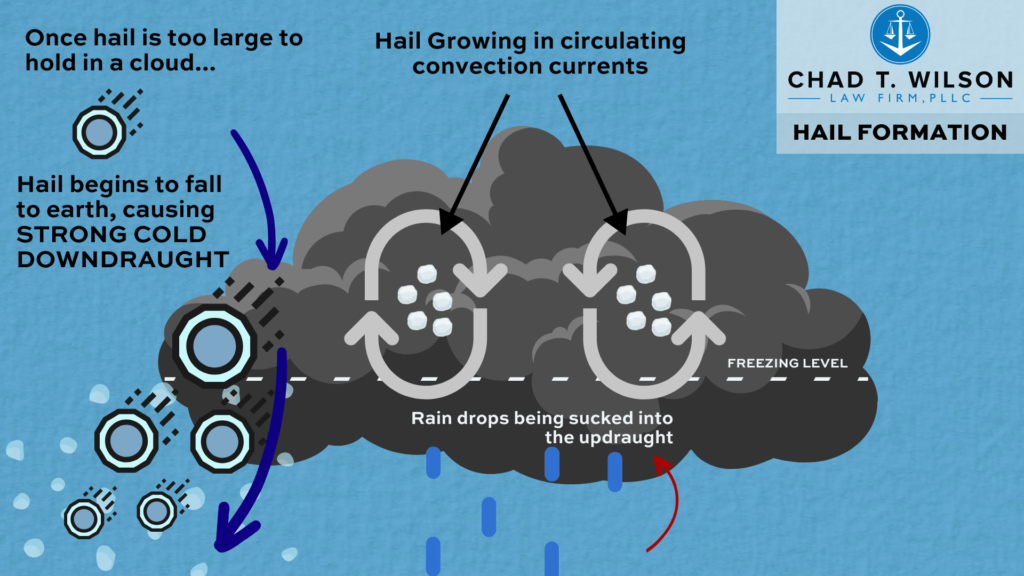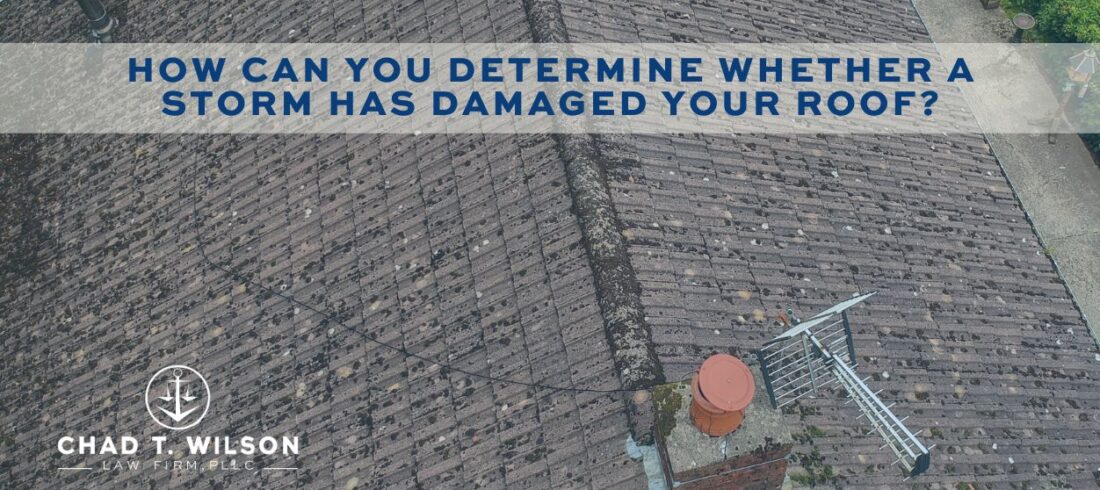Chad T. Wilson – Resources
October 16, 2023
Updated: October 16, 2023 01:55 a.m.
Source: https://cwilsonlaw.com/
Have you ever wondered how hail is formed?
The answer is fairly simple: When water droplets are lifted by an updraft from a thunderstorm over the freezing point of the atmosphere, hail is created. The cooled water or water vapor that frozen water droplets accumulate later freezes when they come into contact with the storm. Therefore, hailstones grow as a result of this process.
Hail and other forms of freezing precipitation, such as sleet, are frequently mistaken. Sleet does not occur in thunderstorms and is more common during the colder months. Hail, by contrast, only occurs during thunderstorms because the updrafts created by the storm cause raindrops that are higher in the atmosphere to freeze.

How does Hail form? Watch the video here.
As the hailstone passes through the updraft and encounters various concentrations of water vapor and cooled water, it frequently takes on a ringed appearance.
Hailstones frequently have a ringed look. The rings stand in for the various settings that the hailstone encounters as it travels through the updraft. A white or opaque layer develops when the hailstone is in an atmosphere that is primarily composed of water vapor. This happens because, as the vapor particles freeze, little air pockets become trapped between them. A transparent layer occurs when the hailstone is surrounded by mostly super-cooled water because the super-cooled water instantly freezes into the hailstone.
In a process known as “wet growth,” hailstones can also expand by adhering to one another. Larger hailstones will move more slowly through the updraft than smaller hailstones do. These hailstones may collide and stick together if the outer layer is not totally frozen. A hailstone can expand swiftly if this technique is repeated repeatedly. Because the smaller hailstones that make up the larger hailstone keep their distinct shapes, when these aggregated hailstones hit the ground, they frequently have a rough or spiky appearance.
Hailstorm damage
Hail can cause a great deal of damage to crops and property. The size of a hailstone affects its terminal velocity, or maximum speed, which increases damage to anything the hailstone strikes. Hail the size of a baseball can travel to the ground at a speed of about 70 mph. Larger hailstones have a speed range between 90 and 100 miles per hour. That is comparable to being struck by a Major League fastball!
Hail damage can be extremely dangerous for crops. When a big hail event occurs, smaller cereals like wheat and barley may have significant yield losses. Early to mid-stage corn plants may typically recover from hail shock, while older plants are more vulnerable to harm. Hail can obliterate a plant’s leaves and topple its stalks, causing sterilization or plant death. To guard against yield losses brought on by hail damage, farmers frequently get crop insurance.
Property can also be seriously threatened by hail. Cars are frequently the most susceptible to damage since the sheet metal that covers them is easily dented. Hail can easily crack and shatter sunroofs, moonroofs, and windshields, which can be deadly if passengers are inside the car. Additionally, hail seriously harms roofing shingles. Larger hailstones have the potential to enter a house through the roof!
Hail that has been blown by the wind can damage siding and smash windows. This extensive damage necessitates pricey repairs and replacements. Since 1949, hail has caused more than $50 billion in property damage in current currencies in the United States. That equals annual hail damage of more than $850 million.
What is the best course of action during a hailstorm?
If you’re inside a building, go into a room inside that isn’t near any windows. Wind-blown hail can hurt people by breaking windows. Stay inside even if hail has stopped falling since there is still a chance of lightning and high winds during a thunderstorm. Your security is crucial!
If you’re driving, get off the road and into a neighboring parking lot or off to the side. To alert other drivers that you have stopped, make sure to activate your emergency flashers. Driving during hail just makes it more likely that it may harm your car. Vehicle windows and windshields are easily damaged by hail. To shield your head from flying glass, turn your body and head toward the center of the car. In case you are struck by glass, cover yourself with blankets and soft things. Move out from under the glass if your car has a sunroof or moon roof since these roofs are particularly prone to breaking from hail.
Standing beneath a tree for cover may seem like a smart idea, but doing so simply raises your risk of getting hurt. Standing beneath a tree increases your risk of electrocution since trees are frequently struck by lightning.
The most instantly devastating type of precipitation is unquestionably hail. Install a NOAA All Hazards radio in your house or place of business to do your part to be weather-savvy. You may protect yourself from the potentially dangerous threat of hail by keeping up with local thunderstorm predictions from the National Weather Service and thunderstorm outlooks from the Storm Prediction Center.
Is your claim being denied or underpaid? Call Chad T. Wilson Law Firm, PLLC.
Speak with one of our attorney if you’re having trouble getting your claim processed or if the insurance company is attempting to pay less for the claim than is reasonable.
Contact us: https://cwilsonlaw.com/contact-us/
Learn more about our attorneys:
https://cwilsonlaw.com/meet-the-team-chad-t-wilson-law-firm-pllc-insurance-attorney/
Follow us on Social media:
https://beacons.ai/chadtwilsonlaw
Contact our Chad T. Wilson Law Firm Office Locations to Schedule a free Consultation.
Chad T. Wilson is an attorney whose firm specializes in property insurance disputes.
Written By:
Alejandro Caro






